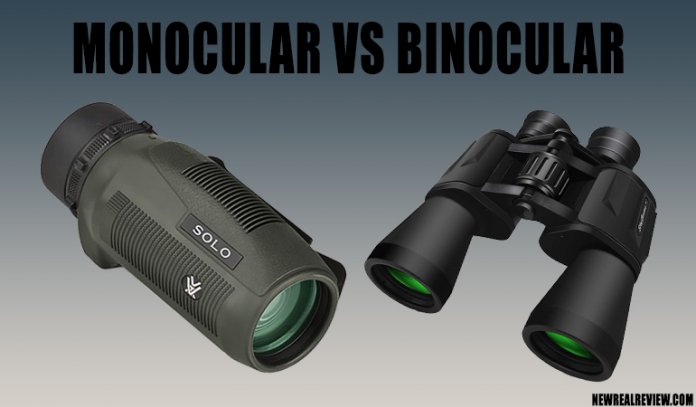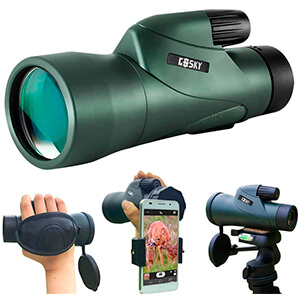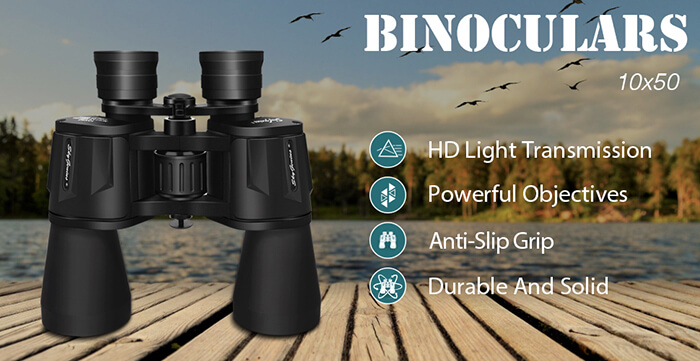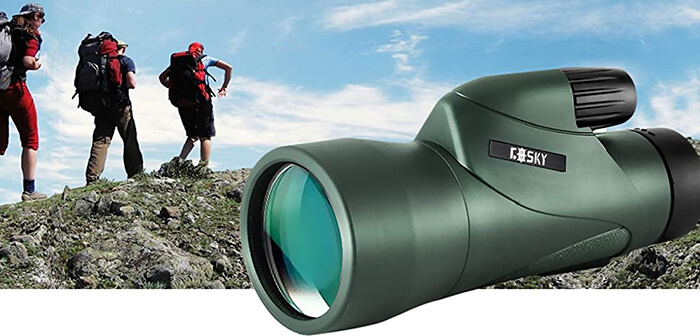Whether you’re hiking, hunting, birdwatching, or simply searching for a high-quality tool to magnify your field of view, you’ve likely considered binoculars. However, monoculars offer dozens of hidden benefits you might not expect. Comparing monoculars and binoculars will reveal the best decision for your setup.
When it comes to monocular vs. binoculars, monoculars are better for portability, photography, and quick usage. However, binoculars reduce eye strain, improve your field of vision, and clarify images much more. Each tool is ideal for various scenarios, so it’s crucial to know why you’ll use it.
Contents
- Monocular vs. Binocular: Origins
- What are the Uses of Monocular & Binocular?
- Performance Differences & Pros and Cons
- When to Choose Monoculars?
- When to Choose Binoculars?
- Final Thoughts on Monocular vs Binocular
This article will also teach you the following details about monocular vs. binoculars:
- An introduction to the history and purpose of monoculars and binoculars;
- What you should expect from both magnification tools;
- Advantages and disadvantages of a monocular vs. binoculars.
Monocular vs. Binocular: Origins
It’s no secret monoculars came before binoculars. A monocular is often seen as half of a set of binoculars, though there are a couple of alterations made through the process.
For example, monoculars often have unique lenses found in old-school binoculars. These lenses are curved to enhance the field of view, improving their results from decade-old monoculars.
Binoculars were invented in the 1820s with a pair of telescopes. While the invention in optics has developed quite a bit, it’s understandable why people would attach them together for better viewing. Soon after, monoculars were invented for portability and better storage solutions.
We’ll further discuss the history and purpose of each gadget below.
Monocular
The monocular was invented shortly after binoculars. Contrary to popular belief, the ancient spyglass isn’t the same as a monocular.
Spy glasses had horrible fields of view, not to mention the fact that they used low-magnification lenses. They weren’t able to curve the objective lens, which limited its capabilities.
Monoculars were made to reduce the clunkiness of binoculars without reducing the magnification. While the images weren’t as clear, there’s no denying the upgrade people found going from a spyglass to a monocular.
Everything became much more visible from a long distance, which was beneficial for sailing, battles, hunting, and more.
Binocular
As mentioned earlier on the page, binoculars were invented in the 1820s as a pair of telescopes, but they were quickly enhanced.
Once the lenses became curved, users could see everything in a much wider picture. Binoculars were used in many battles since their invention, possibly altering the course of history.
These days, binoculars are used in military scenarios with thermal vision and night vision lenses. Traditional binoculars are also used by the military, though they can see hundreds of times further than the original pair of binoculars.
What are the Uses of Monocular & Binocular?
Binoculars are much more common than monoculars, but neither is always better than the other. They both have unique uses and situations when they’re more ideal.
Before you invest in either tool, it’s essential that you know what to expect. Will binoculars improve your hunting kit, or is a monocular the best choice?
When you’re getting a new tool for magnification, you should keep the following three features in your mind:
- Portability is crucial because it affects the dimensions, weight, and excess bulk of the equipment.
- The field of vision is perhaps the most important trait alongside clarity.
- Functionality shouldn’t be overlooked since some tools can be attached to weapons, headgear, and more.
Here’s what you should expect when getting a monocular or binoculars:
Monocular
Getting a monocular will let you clear your pack for other items. It’s often lighter than the alternative, which is a significant perk for many people.
You can use a monocular in a heartbeat, especially if you have the lens corrected for your preferred field of view. That being said, you won’t be able to see a widened picture with a monocular.
If you’re interested in using a monocular, consider the Gosky High Definition Monocular. It comes with a padded grip to prevent slipping, a 12×55 objective lens, and a fog-proof, scratch-resistant lens.
You might also enjoy the smartphone attachment that lets you take crystal-clear zoomed images by sliding your phone on the back of the monocular.
Binocular
If you choose binoculars, you should expect a much wider FOV (field of view), optimal clarity, and reduced eye strain. Binoculars also offer a classic appearance, which may or may not be a factor.
Many pairs are bulky, but you could opt for a folding set of binoculars. They typically provide slightly enhanced clarity since you’ll be using both of your eyes.
Those seeking an affordable, semi-portable pair of binoculars should review the SkyGenius Powerful Binoculars. They have 10×50 magnification, folding capabilities, and clear vision up to 100 yards.
Their lenses prevent light penetration, clarifying everything you see by providing optimal color contrasting.
Performance Differences & Pros and Cons
Binoculars and monoculars are very similar because they provide clear magnification, zooming technology, lightweight designs (though binoculars can be heavy, depending on the materials), and more.
However, there are several clear differences that can’t be overlooked or forgotten. Before you get either of them, you should know the ups and downs of each.
Monoculars are often better for tactical scenarios, and some attach to weapons. Binoculars are great for bird watching, hiking, and more.
There’s a grey area where both tools can be used for multiple purposes, which is why some people stick by their choice regardless of the pros and cons. That being said, let’s analyze the problems and benefits you’ll encounter with these tools below.
Pros of a Monocular
Lightweight & Compact
Monoculars have a significant weight advantage over binoculars. If you’re trying to cut your pack’s weight or prefer ultra-lightweight hiking and cycling, there’s nothing better than a top-notch monocular. It’s almost always half the weight of binoculars.
Unparalleled Portability
Are you tired of sifting through your gear to find your binoculars? Switch to a slim monocular and leave those problems in the past. You can hook a monocular in a side pouch, wear it around your neck without much strain, or carry it in your pocket.
Can Be Attached to Weapons and Headgear
Whether you’re going through a paramilitary scenario or hunting in the wild, nothing beats night vision and thermal vision. Get a monocular with either technology, and you’ll be good to go in numerous outdoor or indoor situations.
Can Be Used With Smartphones
As you saw with the previous example (the Gosky Monocular), you can use your monocular to take HD photos with your smartphone. Most phones don’t have ultra-HD zooming technology, so using a monocular can make quite an improvement.
Cons of a Monocular
Limited Field of Vision
You’re essentially halving the viewing area, which means you won’t see everything you would if you were using binoculars. This limitation makes a monocular much less useful for many applications, especially for long-distance viewing.
May Cause Eye Fatigue After Long-term Usage
Looking through a monocular for too long can strain your viewing eye because you’re putting all of the focus on one side. You won’t experience the same issue with binoculars because both eyes should be open and looking through similar tubes.
Pros of Binoculars
Ultra Wide Field of View
You can see two to three times the area of a monocular. Whether you’re in a dangerous situation or an exciting outdoor adventure, binoculars are the best choice for seeing more scenery. Every movement becomes much more visible thanks to the wider sight picture.
Can Zoom Much Further Than Monoculars
Since they have twice the viewing space, you can often zoom your binoculars much further without hindering the quality. Some monoculars lose their clarity, but that’s not the case with top-of-the-line binoculars. They’re crystal clear for hundreds or thousands of feet ahead of you.
Advanced Technology
This point is based on personal preference, though. If you enjoy smartphone pictures, monoculars are better.
However, many binoculars have a button for instant photographs without bringing your phone along for the ride. This option lets you cut your pack weight to accommodate the added pounds from bringing binoculars.
More Comfortable and Better Eye Relief
They’re ergonomic, shaping your forehead and pocketing your eyes to prevent light penetration. You won’t find the same level of comfort when using a monocular. Paired with the aforementioned lack of eye strain, binoculars feel much more natural than their single-lensed counterpart.
Cons of Binoculars
Not Easy to Focus
Monoculars take the cake when it comes to ease of use and focusing. Binoculars can be difficult to focus on and improve clarity, especially if you have poor eyesight. You’ll make one side clear, but the other will be a little foggy if you don’t have corrective lenses.
Heavy and Less Flexibility
Since they’re twice the size, it’s easy to assume why they’d weigh twice as much. However, many binoculars weigh more than double a monocular because they have bigger focusing wheels to accommodate both lenses. If the weight is an issue, binoculars could be a problem.
Performance Conclusion
As you can see, binoculars are comfortable with better eye relief but a bit heavier than a monocular. On the other hand, a monocular offers smartphone compatibility, portability, and better tactical usages.
Both of them are worth trying. If you have enough time to spare, the focusing downside of binoculars and the monocular’s limited FOV aren’t much of an issue.
Both magnification tools have been used in military operations, outdoor entertainment, and research. You don’t have to worry about either of them going out of style or becoming obsolete.
There are slim and bulky variants of each tool, tactical and traditional options, and smart technological upgrades.
If you want a quick breakdown of both options to know which situations they’re best for, read on.
When to Choose Monoculars?
If you’re looking for a tactical, lightweight solution or something you can use to take pictures with your smartphone, try a monocular.
They might not be as popular as binoculars, but their slim design and lightweight nature make them an easy choice for many people. They might not have the best field of vision, but you can take a quick look at anything within several hundred feet.
Monoculars are a top choice for many military people, police members, and other professional careers that require quick, precise, tactical equipment. They often come with night vision or thermal vision lenses and can be attached to weapons, headgear, and more.
When to Choose Binoculars?
Those who birdwatch, hike, or do outdoor research should opt for binoculars. Having two lenses to look through doubles the field of view and reduces eye strain.
When you’re looking through a monocular for an extended time, your eye will start to strain, leading to unwanted headaches. Since binoculars have a tube for each eye, you can use both of them and stay rested.
If you’re looking for a tool to view plants and animals, they’re typically the best choice. You wouldn’t want to limit yourself by using a monocular, especially if your research is important. You could choose night vision binoculars if you’re working at night, too.
Final Thoughts on Monocular vs Binocular
If you’re stuck between monoculars and binoculars, there are a few simple questions to ask yourself:
- Do you prefer portability or a broader field of view?
- How far do you need to be able to see with your equipment?
- Will you be using it for tactical purposes?
Truthfully, you should have both tools. Monoculars are incredibly convenient and easy to use, whereas binoculars offer a great area of viewing.
Unless you’re through hiking, backpacking, or reducing your carry-on weight, there’s a time and place for both pieces of equipment.






